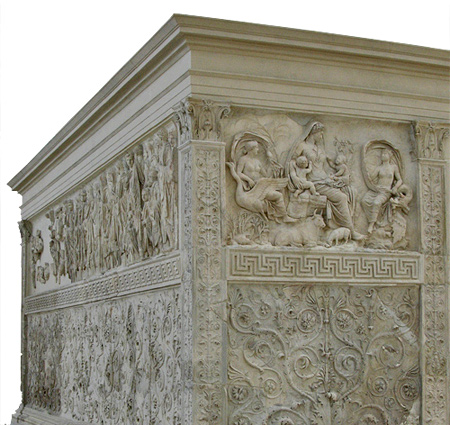
As you walk along the south enclosure wall, you look up at the figures of magistrates and priests, followed by members of the imperial family, in a solemn procession that leads toward the western entrance of the altar, as does the procession on the north wall. You see the tall figure of the emperor Augustus near the beginning of the procession, with a fold of his toga veiling his head indicating his status as chief priest of the state (pontifex maximus) topped by a laurel wreath. His features are youthful and idealized, easily recognizable from portraits on coins and statues across the Empire. In front of Augustus you notice a group of lictors, magistrates' attendants who carry the fasces, bundles of rods symbolizing the power of the state. Behind him walk 4 of the archaic priests called flamines, who wear high-laced patrician shoes, a heavy woolen cloak (laena) and a distinctive leather skull cap topped with a spike made of olive wood (the apex is here ornamented with an embossed palm branch). You recognize the chief of these priests, the Flamen Dialis of Jupiter, by the wooden staff he holds in his right hand; behind him marches the special flaminius lictor, carrying a ritual axe on his shoulder.
Near the center of the procession you see the veiled figure of Marcus Vipsanius Agrippa, chief general, friend and supporter of Augustus and father of the emperor's adopted sons Gaius and Lucius Caesar. Agrippa had returned from settling affairs in the eastern empire in 13 BCE and would have figured prominently in the altar's dedication ceremony, but you remember that he died two years earlier, in 12 BCE, and you think that the sculptors have emphasized this loss by his furrowed brow and sad expression. You believe that the dignified woman behind Aprippa, with a fold of her palla veiling her head topped by a laurel wreath similar to the emperor's, must be the empress Livia, with her eldest son Tiberius behind her; you reflect that like Augustus but in contrast to Agrippa, her face is also youthful and idealized, and you admire the intricate bracelet on her left arm, with a winged victory crowning a kneeling figure. Her hair is worn in the Greek style, parted in the middle with waves flowing toward the back and loose tendrils falling on either side of her neck; this style closely resembles that of Tellus/Pax on the east entrance panel, and you note that both Livia and the goddess are the only females who wear both veil and garland, just as Augustus and Aeneas/Numa are the only males with both wreath and veiled head.
Between Agrippa and Livia is another barbarian boy, with long curly hair and a torque around his neck like the toddler on the north wall. His mother stands behind him with her hand on his head, and you realize that these are eastern hostages, brought back to Rome from the east by Agrippa; you are touched by the way the little boy clutches Agrippa's toga and looks up at Livia.
You think that the young couple gazing fondly at each other must be Augustus's niece Antonia Minor and her husband Drusus, younger son of Livia. Drusus is the only man on the altar dressed in military garb, including hobnailed sandals (caligae) and military cloak (paludamentum), since he had been leading a major campaign against various tribes in Germany at the time. Their young son Germanicus clings tightly to his mother's index finger; he wears a toga praetexta and large bulla, the protective amulet worn only by freeborn Roman citizen boys.
You look at the final family group on the south wall and think that the veiled woman must be Augustus's older niece, Antonia Maior, and her husband Lucius Domitius Ahenobarbus. Between them stand their children, their young son Gnaeus Domitius Ahenobarbus and daughter Domitia. Like his cousin Germanicus, Gnaeus wears a bulla and beautifully draped toga praetexta, but also a laurel wreath on his head; he holds a fold of his uncle Drusus's cloak, while his mother rests her hand on his shoulder. Smiling down at her brother, Domitia wears a less elaborately draped toga praetexta, and the protective amulet dangling from her necklace is a crescent moon (lunula).
As you wonder why women and children are depicted so prominently on this important state monument, you realize that this must have been part of Augustus's program to promote and strengthen the aristocratic Roman family through much of his social legislation. More subtly, however, Augustus was promoting members of his own imperial family and identifying them with the peace and new order that this altar symbolically proclaimed as his accomplishment. You recognize that Ovid was only stating this message more plainly in his lines from the Fasti about the annual sacrifice held at this altar:
Ipsum nos carmen deduxit Pacis ad aram:
haec erit a mensis fine secunda dies.
frondibus Actiacis comptos redimita capillos,
Pax, ades et toto mitis in orbe mane. . . .
tura, sacerdotes, Pacalibus addite flammis,
albaque perfusa victima fronte cadat;
utque domus, quae praestat eam, cum pace perennet
ad pia propensos vota rogate deos.
(Fasti 1.709-12; 719-22) The song itself has led us to the Altar of Peace; this will be the second day from the end of the month of January. O Peace, your elegant hair bound with the laurel leaves of Actium, be present and gently make your home over the whole earth. . . . Priests, add incense to the flames of Peace. Let the white victim fall after his brow has been drenched with wine, and ask the gods, well-disposed to your pious prayers, that the household responsible for peace may, together with that peace, long endure.